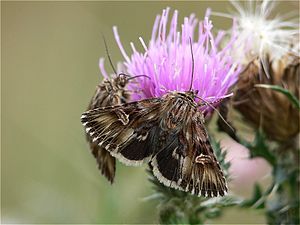Dry grass St. John's wort owl
| Dry grass St. John's wort owl | ||||||||||||
|---|---|---|---|---|---|---|---|---|---|---|---|---|

Dry-grass St. John's wort owl ( Actinotia radiosa ) |
||||||||||||
| Systematics | ||||||||||||
|
||||||||||||
| Scientific name | ||||||||||||
| Actinotia radiosa | ||||||||||||
| ( Esper , 1804) |
The actinotia radiosa ( Actinotia radiosa ) is a butterfly ( moth ) from the family of cutworms (Noctuidae).
features
butterfly
The wingspan of the relatively small moth is 28 to 33 millimeters. The basic color of the forewings varies in mostly dark brownish tones, from which the kidney flaws stand out in cream color. A clear W-sign can be seen in the whitish wavy line. Some fields in the post-fiscal region are lightened yellow. There are alternating yellow and brown fringes on the hem. The hind wings are colored black-brown and show a dark moon spot in the lighter root field.
Caterpillar
Adult caterpillars have a gray-brown, slightly reddish shimmering color. Back and side back lines are narrow and brown-gray, side stripes are broad and tinted reddish-yellow.
Doll
The brownish, shiny doll is short, stocky and has thorns at the rounded end.
Similar species
The butterflies are unmistakable due to the distinctive drawing.
distribution and habitat
The distribution of the species includes southern Europe, the southern part of Central Europe, Asia Minor , southern Russia and the Caucasus . The animals are mainly to be found on flowery dry grasslands and sandy corridors as well as on sunny slopes and heaps. In the mountains they rise to about 1,800 meters.
Way of life
The moths fly in two generations, from April to May and from July to August, are mostly diurnal and like to suckle different flowers. These include bird vetch ( Vicia cracca ), meadow sage ( Salvia pratensis ) as well as adder's head ( Echium ), saspards ( Onobrychis ) and types of thyme ( Thymus ). They only appear occasionally at night in front of artificial light sources or lures . The caterpillars feed on St. John's wort species ( Hypericum ) and prefer their flowers and fruits. During the day they hide. The pupa hibernates in a light web on the ground.
Danger
In Germany, the dry grass St. John's wort owl occurs in a few places in Baden-Württemberg . It is classified in category 1 (critically endangered) on the Red List of Threatened Species .
swell
Individual evidence
- ↑ a b c Michael Fibiger, Hermann Hacker: Amphipyrinae, Condicinae, Eriopinae, Xyleninae (part) . In: Michael Fibiger, László Ronkay, Barry Goater, Martin Honey (eds.): Noctuidae Europaeae . tape 9 . Entomological Press, Sorø 2007, ISBN 978-87-89430-11-9 (English).
- ↑ Walter Forster , Theodor A. Wohlfahrt : The butterflies of Central Europe. Volume 4: Owls. (Noctuidae). Franckh'sche Verlagshandlung, Stuttgart 1971, ISBN 3-440-03752-5 .
- ^ Günter Ebert (Ed.): The butterflies of Baden-Württemberg . 1st edition. tape 6 . Moth IV. Noctuidae 2nd part. Ulmer, Stuttgart (Hohenheim) 1997, ISBN 3-8001-3482-9 .
- ↑ Federal Agency for Nature Conservation (Ed.): Red List of Endangered Animals in Germany . Landwirtschaftsverlag, Münster 1998, ISBN 3-89624-110-9 .
literature
- Michael Fibiger, Hermann Hacker: Amphipyrinae, Condicinae, Eriopinae, Xyleninae (part) . In: Michael Fibiger, László Ronkay, Barry Goater, Martin Honey (eds.): Noctuidae Europaeae . tape 9 . Entomological Press, Sorø 2007, ISBN 978-87-89430-11-9 (English).
- Günter Ebert (Ed.): The butterflies of Baden-Württemberg . 1st edition. tape 6 . Moth IV. Noctuidae 2nd part. Ulmer, Stuttgart (Hohenheim) 1997, ISBN 3-8001-3482-9 .
Web links
- Lepiforum eV photos
- www.schmetterlinge-deutschlands.de Endangerment
- Actinotia radiosa in Fauna Europaea
